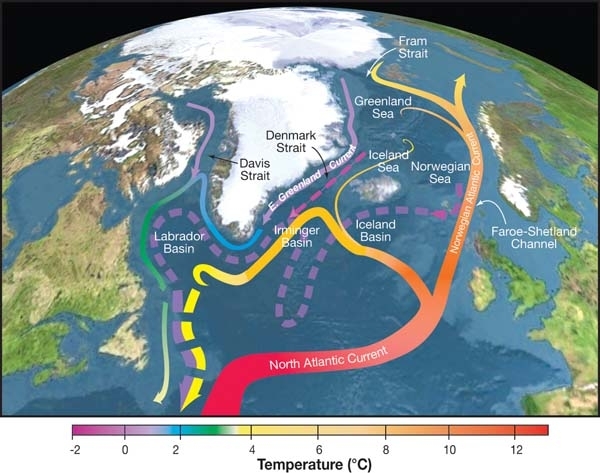The Atlantic meridional overturning circulation (AMOC) is a major tipping element in the climate system and a future collapse would have severe impacts on the climate in the North Atlantic region. In recent years weakening in circulation has been reported, but assessments by the Intergovernmental Panel on Climate Change (IPCC), based on the Climate Model Intercomparison Project (CMIP) model simulations suggest that a full collapse is unlikely within the 21st century. Tipping to an undesired state in the climate is, however, a growing concern with increasing greenhouse gas concentrations. Predictions based on observations rely on detecting early-warning signals, primarily an increase in variance (loss of resilience) and increased autocorrelation (critical slowing down), which have recently been reported for the AMOC. Here we provide statistical significance and data-driven estimators for the time of tipping. We estimate a collapse of the AMOC to occur around mid-century under the current scenario of future emissions. The Atlantic meridional overturning circulation (AMOC) is a major tipping element in the climate system. Here, data-driven estimators for the time of tipping predict a potential AMOC collapse mid-century under the current emission scenario.
.
9 degree drop would be disruptive and happen in less than a century.
Even if the modem needs more validation we should not wait to act.
typo : modem … * model
Cold Europe means warm somewhere else. Likely it means more extremes. Heat will flow equator to pole; if it’s not via the AMOC, it will be another process.
.
Just so you are aware, The British isles is a political term popularised in an attempt legitimise the occupation of Ireland.
.
British and Irish will do, thanks for taking the information on board.
I sometimes say northwestern European archipelago just for the laugh though.
Yes, and the other process will likely be catastrophic winds.
Wishful thinking is how we go here.
What are the effects for other parts of the world like Asia and North America? I read somewhere that northern US states will become the most tolerable in the US, and Florida (if it doesn’t drown first) and a lot of the south are gonna be uninhabitable.
.
Removed by mod
So… you’re saying everything is awesome?
Eh. Let em go. They’ve built for the cold. It’s the heat that really gets to them apparently. Everyone likes to forget that the world is still technically in an ice age lmao people crying about the amazon love to gloss over the fact that it’s likely man-made agriculture gone completely unchecked for centuries. If we did it once, we can certainly do it again.
You do your username justice.
Block this user, its the third time ive seem them trolling like this. You wont miss anything.
I’m starting to miss Reddit’s feature to collapse heavily downvoted comments.
Conservatives are achieving their climate destruction goals ahead of schedule.
A lot of people know that this current keeps Europe substantially warmer than it otherwise would be. But this warm, moist air, also contributes substantially to rainfall in Europe. If the current collapses, severe drought may become the norm for much of Europe, which will have a huge impact on regional and global food production.
And of course, it will impact many other areas substantially as well. Some predictions show substantial reductions in precipitation in West Africa and India, which would also be devastating.
… at wikipedia :
The Atlantic meridional overturning circulation (AMOC) is part of a global thermohaline circulation in the oceans and is the zonally integrated component of surface and deep currents in the Atlantic Ocean. It is characterized by a northward flow of warm, salty water in the upper layers of the Atlantic, and a southward flow of colder, deep waters. These “limbs” are linked by regions of overturning in the Nordic and Labrador Seas and the Southern Ocean, although the extent of overturning in the Labrador Sea is disputed.[1][2] The AMOC is an important component of the Earth’s climate system, and is a result of both atmospheric and thermohaline drivers.

Isn’t this what Dennis Quaid warned us about in The Day After Tomorrow?








